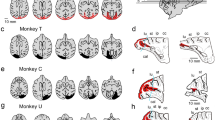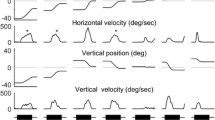Summary
The frontal eye field (FEF) and superior colliculus (SC) are thought to form two parallel systems for generating saccadic eye movements. The SC is thought classically to mediate reflex-like orienting movements. Thus it can be hypothesized that the FEF exerts a higher level control on a visual grasp reflex. To test this hypothesis we have studied the saccades of patients who have had discrete unilateral removals of frontal lobe tissue for the relief of intractable epilepsy. The responses of these patients were compared to those of normal subjects and patients with unilateral temporal lobe removals. Two tasks were used. In the first task the subject was instructed to look in the direction of a visual cue that appeared unexpectedly 12° to the left or right of a central fixation point (FP), in order to identify a patterned target that appeared 200 ms or more later. In the second “anti-saccade” task the subject was required to look not at the location of the cue but in the opposite direction, an equal distance from FP where after 200 ms or more the patterned target appeared. Three major observations have emerged from the present study. (a) Most frontal patients, with lesions involving both the dorsolateral and mesial cortex had long term difficulties in suppressing disallowed glances to visual stimuli that suddenly appeared in peripheral vision. (b) In such patients, saccades that were eventually directed away from the cue and towards the target were nearly always triggered by the appearance of the target itself irrespective of whether or not the “anti-saccade” was preceded by a disallowed glance. Those eye movements away from the cue were only rarely generated spontaneously across the blank screen during the cue-target time interval. (c) The latency of these visually-triggered saccades was very short (80–140 ms) compared to that of the correct saccades (170–200 ms) to the cue when the cue and target were on the same side, thereby suggesting that the structures removed in these patients normally trigger saccades after considerable computations have already been performed. The results support the view that the frontal lobes, particularly the dorsolateral region which contains the FEF and possibly the supplementary motor area contribute to the generation of complex saccadic eye-movement behaviour. More specifically, they appear to aid in suppressing unwanted reflex-like oculomotor activity and in triggering the appropriate volitional movements when the goal for the movement is known but not yet visible.
Similar content being viewed by others
References
Albano JE, Mishkin M, Westbrook LE, Wurtz RH (1982) Visuomotor deficits following ablation of monkey superior colliculus. J Neurophysiol 48: 338–351
Becker W, Jürgens R (1979) An analysis of the saccadic system by means of double step stimuli. Vision Res 19: 967–983
Bianchi L (1895) The functions of the frontal lobes. Brain 18: 497–522
Bizzi E (1968) Discharge of frontal eye field neurons during saccadic and following eye movements in unanesthetized monkeys. Exp Brain Res 6: 69–80
Boch R, Fischer B, Ramsperger E (1984) Express-saccades of the monkey: Reaction times versus intensity, size, duration and eccentricity of their targets. Exp Brain Res 55: 223–231
Bruce CJ, Goldberg ME (1981) Frontal eye fields in monkey: classification of neurons discharging before saccades. Soc Neurosci Abstr 7: 131
Bruce CJ, Goldberg ME (1985) Primate frontal eye fields: I. Single neurons discharging before saccades. J Neurophysiol (in press)
Butter CM (1964) Habituation of responses to novel stimuli in monkeys with selective frontal lesions. Science 144: 313–315
Conel JL (1939–1963) The postnatal development of human cerebral cortex, Vols 1–6. Harvard University Press, Cambridge
Crowne DP, Yeo CH, Russell IS (1981) The effects of unilateral frontal eye field lesions in the monkey: visual-motor guidance and avoidance behaviour. Behav Brain Res 2: 165–187
Ferguson GA (1981) Statistical analysis in psychology and education (5. edn). McGraw Hill, New York
Fischer B, Boch R (1983) Saccadic eye movements after extremely short reaction times in the monkey. Brain Res 260: 21–26
Fischer B, Boch R, Ramsperger E (1984) Express-saccades of the monkey: effect of daily training on probability of occurrence and reaction time. Exp Brain Res 55: 232–242
Fuster JM (1981) Prefrontal cortex in motor control. In: Brooks VB (ed) Sect 1, The nervous system. Am Physiol Soc, Bethesda (Handbook of Physiology), pp 1149–1178
Goldberg ME, Bruce CJ (1981) Frontal eye fields in the monkey: eye movements remap the effective coordinates of visual stimuli. Soc Neurosci Abstr 7: 131
Goldberg ME, Bushnell MC (1981) Behavioral enhancement of visual responses in monkey cerebral cortex. II. Modulation in frontal eye fields specifically related to saccades. J Neurophysiol 46: 773–787
Guitton D, Buchtel HA, Douglas RM (1982) Disturbances of voluntary saccadic eye movement mechanisms following discrete unilateral frontal lobe removals. In: Lennerstrand G, Zee DS, Keller EL (eds) Functional basis of ocular motility disorders. Academic Press, Oxford, pp 497–499
Guitton D, Mandl G (1974) The effect of frontal eye field stimulation on unit activity in the superior colliculus of the cat. Brain Res 68: 330–334
Guitton D, Mandl G (1976) The convergence of inputs from the retina and the frontal eye fields upon the superior colliculus in the cat. Exp Brain Res Suppl 1: 556–562
Hallett PE (1978) Primary and secondary saccades to goals defined by instructions. Vision Res 18: 1279–1296
Hallett PE, Adams BD (1980) The predictability of saccadic latency in a novel voluntary oculomotor task. Vision Res 20: 329–339
Hannon R, Kamback (1972) Effects of dorsolateral frontal lesions on responsiveness to various stimulus parameters in the pigtail monkey. Exp Neurol 37: 1–13
Heilmann KM, Valenstein E (1972) Frontal lobe neglect in man. Neurology 22: 660–664
Hess S, Burgi S, Bucher V (1946) Motor function of tectal and tegmental area. Mschr Psychiat Neurol 112: 1–52
Hikosaka O, Wurtz RH (1983a) Visual and oculomotor functions of monkey substantia nigra pars reticulata. I. Relation of visual and auditory responses to saccades. J Neurophysiol 49: 1230–1253
Hikosaka O, Wurtz RH (1983b) Visual and oculomotor functions of monkey substantia nigra pars reticulata. II. Visual responses related to fixation of gaze. J Neurophysiol 49: 1254–1267
Hikosaka O, Wurtz RH (1983c) Visual and oculomotor functions of monkey substantia nigra pars reticulata. III. Memory contingent visual and saccade responses. J Neurophysiol 49: 1268–1284
Hikosaka O, Wurtz RH (1983d) Visual and oculomotor functions of monkey substantia nigra pars reticulata. IV. Relation of substantia nigra to superior colliculus. J Neurophysiol 49: 1285–1301
Holmes G (1938) The cerebral integration of ocular movements. Br Med J 2: 107–112
Jeannerod M (1972) Rôle du cortex frontal dans la motricité oculaire. Rev Otoneuro-Ophtal 44: 187–203
Jeannerod M, Kiyono S, Mouret J (1968) Effets des lésions frontales bilatérales sur le comportement oculo-moteur chez le chat. Vision Res 8: 575–582
Kennard MA, Ectors L (1938) Forced circling in monkeys following lesions of the frontal lobes. J Neurophysiol 1: 45–54
Künzle H, Akert K (1977) Efferent connections of cortical area 8 (frontal eye fiels) in Macaca fascicularis. A reinvestigation using the autoradiographic technique. J Comp Neurol 173: 147–164
Kuypers HGJM, Lawrence DG (1967) Cortical projections to the red nucleus and the brain stem in the Rhesus monkey. Brain Res 4: 151–188
Latto R, Cowey A (1971a) Visual field defects after frontal eyefield lesions in monkeys. Brain Res 30: 1–24
Latto R, Cowey A (1971b) Fixation changes after frontal eye-field lesions in monkeys. Brain Res 30: 25–36
Leichnetz GR (1980) An anterogradely-labeled prefrontal corticooculomotor pathway in the monkey demonstrated with HRP gel and TMB neurohistochemistry. Brain Res 198: 440–445
Leichnetz GR (1981) The prefontal cortico-oculomotor trajectories in the monkey. J Neurol Sci 49: 387–396
Leichnetz GR, Spencer RF, Hardy SGP, Astruc J (1981) The prefrontal corticotectal projection in the monkey: an anterograde and retrograde horseradish peroxidase study. Neuroscience 6: 1023–1041
Lisberger SG, Fuchs AF, King WM, Evinger LC (1975) Effect of mean reaction time on saccadic responses to two step stimuli with horizontal and vertical components. Vision Res 15: 1021–1025
Mays L, Sparks DL (1980) Dissociation of visual and saccaderelated responses in superior colliculus neurons. J Neurophysiol 43: 207–232
Melamed E, Larsen B (1979) Cortical activation pattern during saccadic eye movements in humans: localization by focal cerebral blood flow increases. Ann Neurol 5: 79–88
Milner B (1975) Psychological aspects of focal epilepsy and its neurosurgical management. In: Purpura DP, Penry JK, Walter RD (eds) Advances in neurology. Raven Press, New York, pp 299–321
Mishkin M (1964) Perseveration of central sets after frontal lesions in monkeys. In: Warren JM, Akert K (eds) The frontal granular cortex and behavior. McGraw-Hill, New York, pp 219–241
Moll L, Kuypers HGJM (1977) Premotor cortical ablations in monkeys: contralateral changes in visually guided reaching behaviour. Science 198: 317–319
Pandya DN, Vignolo LA (1971) Intra- and interhemispheric projections of the precentral premotor and arcuate areas in the rhesus monkey. Brain Res 26: 217–233
Penfield W, Jasper H (1954) Epilepsy and the functional anatomy of the human brain. Little Brown & Co., Boston
Penfield W, Boldrey E (1937) Somatic motor and sensory representation in the cerebral cortex of man as studied by electrical stimulation. Brain 60: 389–443
Penfield W, Rasmussen T (1950) The cerebral cortex in man. Macmillan, New York
Pribram KH (1961) A further experimental analysis of the behavioral deficit that follows injury to the primate frontal cortex. Exp Neurol 3: 432–466
Rasmussen T, Penfield W (1948) Movement of head and eyes from stimulation of human frontal cortex. Res Publ Assoc Res Nerv Ment Dis 27: 346–361
Robinson DA (1981) Control of eye movements. In: Brooks VB (ed) Sect 1, The nervous system. Am Physiol Soc, Bethesda (Handbook of Physiology)
Robinson DA, Fuchs AF (1969) Eye movements evoked by stimulation of the frontal eye fields. J Neurophysiol 32: 637–648
Schiller PH, Koerner F (1971) Discharge characteristics of single units in superior colliculus of the alert rhesus monkey. J Neurophysiol 34: 920–936
Schiller PH, Stryker M (1972) Single-unit recording and stimulation in superior colliculus of the alert rhesus monkey. J Neurophysiol 35: 915–924
Schiller PH, Sandell JH (1983) Interactions between visually and electrically elicited saccades before and after superior colliculus and frontal eye field ablations in the rhesus monkey. Exp Brain Res 49: 381–392
Schilller PH, True SD, Conway JL (1980) Deficits in eye movements following frontal eye-field and superior colliculus ablations. J Neurophysiol 44: 1175–1189
Sparks DL, Mays LE (1980) Movement fields of saccade-related burst neurons in the monkey superior colliculus. Brain Res 190: 39–50
Sparks DL, Porter ID (1983) Spatial localization of saccade targets. II. Activity of superior colliculus neurons preceding compensatory saccades. J Neurophysiol 49: 64–74
Stanton GB, Bruce C, Goldberg ME (1982) Organization of subcortical projections from saccadic eye movement sites in the macaque's frontal eye fields. Soc Neurosci Abstr 8: 293
Welch K, Stuteville P (1958) Experimental production of unilateral neglect in monkeys. Brain 81: 341–347
Wheeless LL, Boynton RM, Cohen GH (1966) Eye-movement responses to step and pulse-step stimuli. J Opt Soc Am 56: 956–960
Wurtz RH, Albano JE (1980) Visual-motor function of the primate superior colliculus. Ann Rev Neurosci 3: 189–226
Wurtz RH, Mohler CW (1976) Enhancement of visual responses in monkey striate cortex and frontal eyefields. I Neurophysiol 39: 766–772
Zee DS (1984) Ocular motor control: the cerebral control of saccadic eye movements. In: Lessell S, van Dalen JTW (eds) Neuro-Ophthalmology, Vol 3. Elsevier, Amsterdam New York Oxford, pp 141–156
Zernicki B (1972) Orienting response hypernormality in frontal cats. Acta Neurobiol Exp 32: 393–415
Author information
Authors and Affiliations
Rights and permissions
About this article
Cite this article
Guitton, D., Buchtel, H.A. & Douglas, R.M. Frontal lobe lesions in man cause difficulties in suppressing reflexive glances and in generating goal-directed saccades. Exp Brain Res 58, 455–472 (1985). https://doi.org/10.1007/BF00235863
Received:
Accepted:
Issue Date:
DOI: https://doi.org/10.1007/BF00235863




